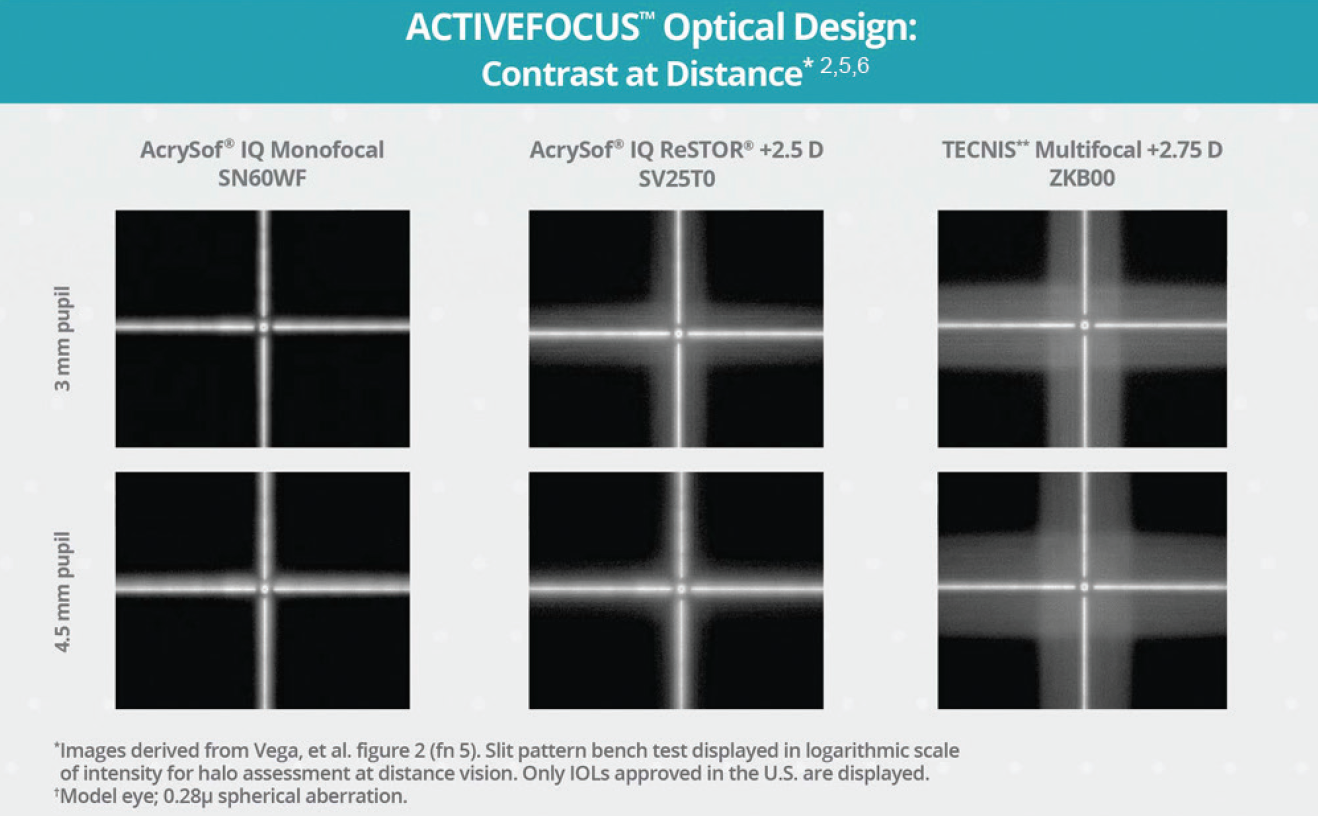A recent survey of anterior segment surgeons found that presbyopia correction for optimized distance vision was more important than other vision attributes—more important than near or intermediate vision.1
I agree with that. I have found that patients opting for a lens that will address their presbyopia, want a full range of vision, but most of all, they do not want to compromise their distance vision. This is the prime reason why I offer the AcrySof IQ ReSTOR +2.5 D IOL with ACTIVEFOCUS optical design to these patients.
Initially, I thought the positive results were due to the fact that this lens provides great intermediate vision, because that is the vision patients use for most daily life activities and hobbies. What I have since come to appreciate is that the distance vision is the key reason patients are so satisfied with their postoperative vision.
What further distinguishes the AcrySof IQ ReSTOR +2.5 D IOL with ACTIVEFOCUS optical design compared with other IOL options is the contrast sensitivity profile (Figure).2-4 Light diffusion across the seven-step apodized diffractive areas is efficiently managed so that more overall light is allocated to distance focal points at any pupil size compared with other presbyopia-correcting IOL designs.2,5,6 This has two benefits: contrast sensitivity that is comparable to a monofocal2-4 and reduced potential for visual disturbances.2,7

Figure. Light diffusion across the seven-step apodized diffractive areas is efficiently managed so that more overall light is allocated to distance focal points at any pupil size compared with other IOL designs.2,5,6
Combined, the fact that the central zone is dedicated to distance, the contrast sensitivity profile, and reduced potential for glare and halo means that many more patients are candidates for this lens. It is more forgiving than other IOLs. I have even used it in patients with previous LASIK, because I am not concerned about light getting split across vision zones. It is also important to me that the AcrySof IQ ReSTOR +2.5 D IOL with ACTIVEFOCUS optical design is available in a toric model,8 so in addition to reducing myopia or hyperopia, we can address astigmatism, as well.
The main reason we offer the AcrySof IQ ReSTOR +2.5 D IOL with ACTIVEFOCUS optical design is because we are getting great results. We are giving better vision to our patients than in the past, including better quality of distance than ever before with a multifocal lens. We are also not compromising their vision by reducing contrast sensitivity and we are enabling the intermediate vision our active patients need most. In my experience, patient satisfaction is high and we don’t have the uncomfortable situations where patients are coming back complaining about their vision and dissatisfied with the choice they have made.9
My strategy with this technology is to implant the dominant eye first targeting emmetropia and distance plano vision. If the patient is satisfied with the distance, intermediate, and reading vision, we use the same approach in the second eye, but if they want additional near vision, there is opportunity to aim for mini-monovision or to use the AcrySof IQ ReSTOR +3.0 D IOL in the contralateral eye8—that is just another way we can use this technology to enhance the outcome.
1. Alcon data on file (2015-2016 Presbyopia -Correcting IOL Physsician’s Survey n=90).
2. Alcon Data on File (April 11, 2016).
3. AcrySof IQ ReSTOR +2.5 D IOL Directions for Use.
4. Alcon Data on File (Aug 7, 2013).
5. Alcon Data on File (Oct 17, 2016).
6. Vega F, Alba-Bueno F, Millán MS, Varon C, Gil MA, Buil JA. Halo and through-focus performance of four diffractive multifocal intraocular lenses. Invest Ophthalmol Vis Sci. 2015;56(6):3967-3975 (study conducted with corneal model eye with 0.28μ spherical aberration).
7. Alcon Data on File (May 17, 2016).
8. AcrySof IQ ReSTOR Toric IOL Directions for Use.
9. Henderson B, Solomon K, Masket S, et al. A survey of potential and previous cataract-surgery patients: what the ophthalmologist should know. Clin Ophthalmol. 2014;8:1595-1602.
AcrySof, ACTIVEFOCUS and ReSTOR are trademarks of Novartis. All other brand/product names are the trademarks of their respective owners.

